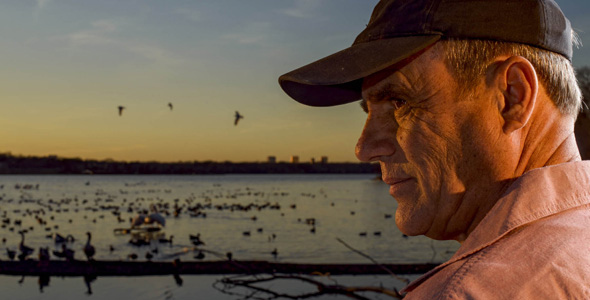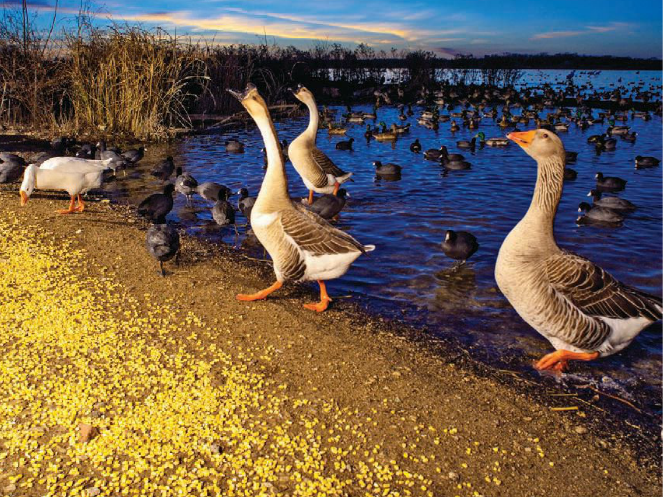Goose godfather Charles Fussell had his prime-time debut earlier this week on WFAA television. We featured Charles last year in our cover story, Wonderful White Rock Lake World. Nice to see this interesting man getting some air time.
Charles appeared on our radar a couple years ago following the mysterious (or not-so mysterious, if you ask him) disappearance of Wilbur Goose. An excerpt from the story:
The signs and ads started appearing around the neighborhood and on digital message boards in mid-April last year.
“Urgent: Wilbur Goose, leader of a big goose gaggle at White Rock Lake, is missing.”
The pleas for Wilbur’s safe return initially were met with amusement and a spattering of jokes — “The goose is on my kitchen table” or “Have you checked inside the coyotes?”
But if it wasn’t a prank, and it wasn’t, the obvious question is, there are dozens upon dozens of geese at White Rock Lake, so how do you know that one, in particular, is missing?
White Rock Lake frequenter Annette Abbott chuckles at the query.
“If you ever met Wilbur,” she says, “you would understand.”
Wilbur wasn’t just any wild waterfowl. He was a lover — had a girlfriend goose, Priscilla, who stuck by him until her 2010 death. They were “the reigning royalty of the goose gaggle,” Abbott says.
Wilbilla, as it were.
Wilbur was a prankster. He loved to play and was known to “goose” (pinch one on the backside) from time to time.
He was brave — known to stare down dogs.
He was a friend. He’d eat crackers right out of your hand, but he especially loved whole grain honey bread. If you approached the lake by car, Wilbur might waddle up and peck on your window, Abbott says. Priscilla might try to get in the passenger seat.
Abbott met Wilbur eight years back, when the grand goose and his mate were living at The Point on West Lawther (he later joined the east side gaggle). Abbott says she was going through an emotional rough patch and she bonded with Wilbur as one might with a pet.
“You know how your dog sometimes gives you that look like, ‘I don’t know what’s wrong, but I’m here for you and it will be OK’? Well, that’s how Wilbur was. He would attach to those who needed a friend. That’s kind of how Charles met him too.”
Charles Fussell, a plumber, is Abbott’s neighbor and friend who also is one of the White Rock geese’s greatest allies. Even after long unforgiving workdays, he reports via pickup truck to Sunset Bay, on the east side of White Rock — most evenings for the past eight-plus years — to feed the fowl, primarily corn (often 200 pounds in a day) and wheat bread, he says. The birds know the plumber. Even if they are far out on the water when he arrives, they scuttle up to shore at the familiar sound of his engine.
Fussell resembles the Pied Piper as he walks to the shoreline with ducks and geese tugging at his jeans, Abbott says.
Whenever possible, this plumber purchases geese from dealers, for about $40 a pop, purely in order to save them from poor living conditions and premature deaths. He rescued the first couple of geese from a dealer in Sunnyvale about eight years ago and one of those is still living at White Rock. They do well with the relocation, he says.
“They immediately take to the lake and become a part of the community,” he says. “It’s such a good life for them, plus, the people at the lake enjoy them. (The geese) almost have the sensibilities of a dog in the way that they gravitate toward and relate with people.”
A goose can live as long as 35 years, Fussell says. He suspects Wilbur was 15 or maybe 20. The geese — a mix of Canada, African, Chinese Toulose, Pilgrim and Emden — are savvy when it comes to survival. Even without human help, they could live on naturally occurring vegetation, Fussell says. And they protect themselves from coyotes and other predators, possibly, by appointing lookouts. “At night,” Abbott says, “there are noticeably four sentries surrounding the sleeping gaggle in the waters near the Bath House. They may appear to be asleep, but they sit up and make noise when some seeming danger approaches.”
No goose has quite taken the place of Wilbur since his disappearance — which Fussell attributes either to a coyote or bobcat-type hunter or a human goose-napper — but Abbott says those with distinct personalities get nicknames. “There’s Laurel and Hardy, for example, a regular slapstick comedy act,” she notes.
Fussell admits it is difficult to know he can’t entirely protect these loveable animals, with whom he feels such kinship, but he knows that their lives at the lake, while not 100-percent danger free, are joyful.
“They love freedom so much, it’s worth the risk. If any of them could talk, I am certain they would say they would rather be out here than safe in a cage somewhere.”
Now, a fund has been set up to help care for the White Rock Lake waterfowl. You also can keep up with them via the Wilbur Goose Facebook page.







